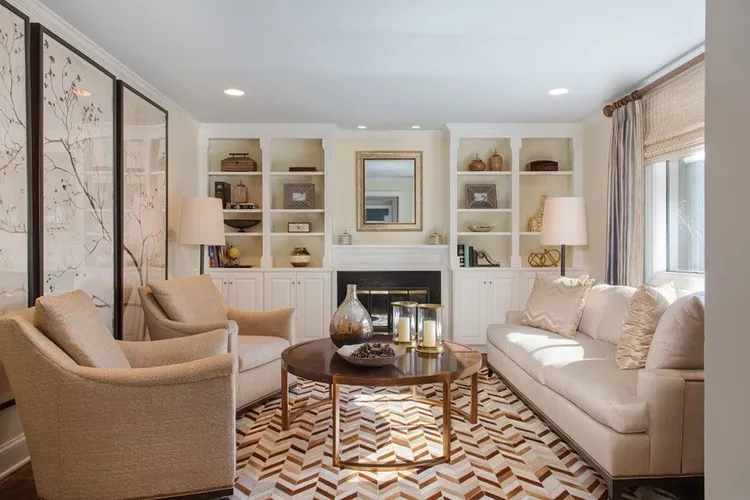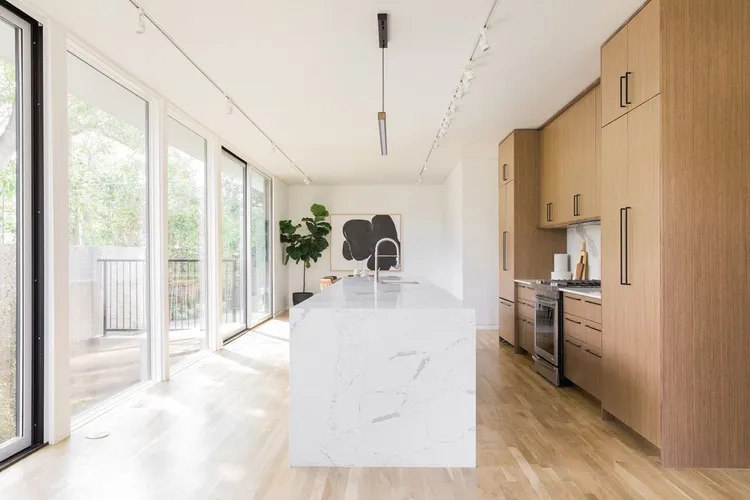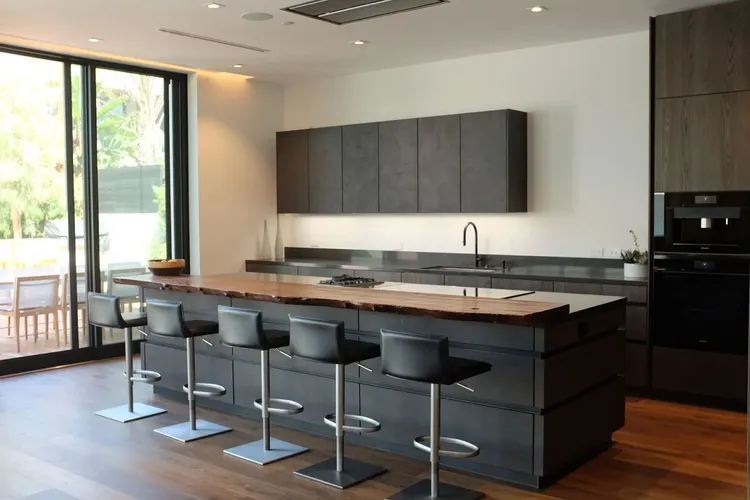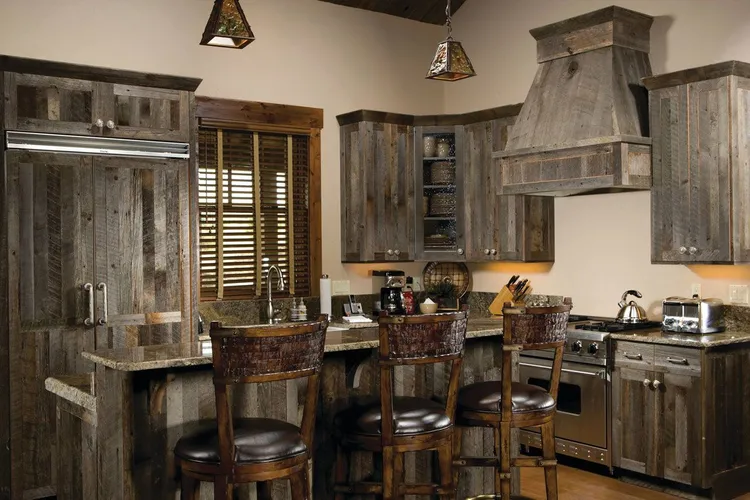Our recommendations are made independently through Research & Testing. We may receive commissions from purchases made via our links.
Five Excellent Kitchen Layout Ideas for Your Next Remodel
About to restyle your kitchen? Here are five kitchen layout ideas that will give you the best balance between form and function.
It doesn’t matter whether your kitchen is cramped or spacious, filled with top of the line gadgets or basic ones. So long as you have a great layout, you will be able to make the most out of your cooking space.
It’s very easy to tell when a kitchen has been carefully thought out. Moving around the space is simple and effortless. All of the appliances, cooking tools, and cabinetry needed on a daily basis can be accessed quickly. A well-planned kitchen looks appealing and inviting, even if it’s a small, confined space.
In today’s article, we’ll be exploring five great kitchen layout ideas for you to try the next time you’re looking to remodel your space!

How to Design an Ergonomic Kitchen
At the core of a good kitchen layout plan is ergonomics. Simply put, ergonomics in kitchen design involves making a cooking space that best suits its users’ needs.
The Four Factors of Kitchen Ergonomics
Comfort
You shouldn’t feel any kind of discomfort or annoyance while inhabiting and using the space.
For example, if you have to walk for a full minute to take the dirty dishes from the kitchen island to the dishwasher, the design has failed the comfort criterion. To remedy this you could try repositioning the dishwasher so that it is closer to the island. It will help you feel a lot less tired after a meal.
Safety
The kitchen — with its many potentially hazardous appliances such as gas stoves — has to be designed with safety in mind.
There has to be adequate ventilation throughout the room to remove harmful cooking fumes. A fire extinguisher should be nearby to combat any fire that may occur. And no part of the kitchen (such as a doorway or cabinetry) should interfere with the safe operation of any appliance.
Functionality
Whatever work you have to do in your kitchen, you must be able to do it efficiently and painlessly.
To illustrate this point, think back to the last time you unloaded your dishwasher. Most people have to gather up their flatware and walk a short distance to the drawer where they’re kept. This isn’t a very good arrangement functionality-wise. It is time-consuming and, more importantly, tiring.
Instead, clear up a drawer right beside or over the dishwasher and put them in there. You’ll save yourself some walking, time, and energy.
Aesthetic
Although the function of a kitchen must always go before form, it doesn’t mean your kitchen should slack off in the aesthetics department. After all, it is still a living space in your home and one you probably use a lot.
You should feel proud and inspired any time you enter your kitchen.
It may seem like a tall order. Fortunately, as you will soon learn, balancing form and function is a lot easier than you’d think!
Kitchen Work Triangle: What Is It?
The kitchen work triangle is a design principle that you can utilize to find a layout that is both functional and beautiful. First devised in the 1920s, designers and architects have regularly used it to build residential kitchens.
It separates your kitchen space into three areas, each one corresponding to a critical function any kitchen must be able to provide:
- Storage: refrigerator
- Food preparation: stove top
- Cleaning: sink
On a blueprint, if you connect these three things together, you will get a triangle (hence the name). The area inside of this triangle must be as free from traffic as possible. The point is to reduce crowding, which will allow the user to move around, prepare food, and access storage cabinets and drawers more easily.
The benefits are plentiful. Such a design reduces frustration, saves you a lot of time, and generally makes the kitchen a lot more efficient to use.
How to Draw a Work Triangle
For best results, you will need an accurate measurement and blueprint of your kitchen. This includes the arrangement of every cabinet, drawer, and appliance that you currently have installed.
Alternatively, you can get more hands-on and just use a measuring tape to approximate the numbers. Remember to get yourself a notepad too, to write down the data.
When you’re ready, either draw or measure three lines connecting the refrigerator, stove top, and sink together to form a triangle. That is the current work triangle of your kitchen.
Write down the measurements of the three connecting lines. You don’t need to be exact; approximation will do.
Once you have the numbers, check out these three bullet points to see if the work triangle of your current kitchen layout cover any:
- The length of each triangle leg is between 4 and 9 feet.
- The sum of all three legs’ measurements is between 13 – 25.9 feet. It should not exceed 26 feet.
- No cabinetry, appliance, or similar objects should cut through the leg of the triangle by more than 12 inches.
- There is typically no major traffic through the triangle during day-to-day use.
If the work triangle of your kitchen fits all four points, your space is already very well-optimized. There’s no need to change anything! However, if your triangle doesn’t meet the criteria, you may consider remodeling in the future.
The Work Zone Approach
As great as the work triangle principle is, though, it has become quite antiquated.
Like we mentioned earlier, it is a concept that was thought up in the early 20th century. Kitchens in this period are very different from the ones we have today. They were a lot smaller in size and were built purely as a utilitarian cooking space for housewives.
In the 21st century, the state of kitchen design is very different.
It is no longer built to accommodate just a single cook. A modern household can have several cooks inhabiting the space at the same time. Thus, you will probably find a modern family-sized kitchen to be a lot larger than it was in the past.
The function of the modern kitchen is also very different. It can act as a secondary living room, a dining area, an entertainment area, or even an office. In other words, it has become a common hub for your home just as much as the living room.
Due to this dramatic shift in design, you can’t really apply the bare-bone work triangle to a modern kitchen and expect good results. To fix that, you have to use the work zone approach.
What Is the Work Zone Approach?
In this approach, instead of segmenting your cooking space into just three areas, you can divide it into several. The more functions you would like your kitchen to provide, the more areas you can add.
Naturally, this will also increase the amount of “triangles” that you have in your kitchen too. Space out these triangles carefully to avoid traffic jams.
How to Use the Work Zone Approach
Other than the three basic areas (storage, food prep, and cleaning), you can add the following areas to the plan:
- Working area: a working area will include a working surface (the kitchen island and some chairs will do) and charging outlets. You can install common electrical outlets and use charging bricks, but we highly recommend finding outlets with special USB plugs.
- Entertainment area: it is no longer uncommon to have a TV in the kitchen. Additionally, you can add a bar and accompanying stools to create a zone where you can hold informal conversations with guests and friends over drinks.
- Dining area: the kitchen can be merged with the dining room by adding a dining area. Islands and peninsulas will fit great in this case. They may also double as a food preparation area, working surface, or entertainment space, too.
Your options aren’t limited to just these. Add custom areas to suit your needs.
Nonetheless, you should be conscious of how much space you have in your kitchen. The larger your kitchen area is, the more purposes it can take on without being too cramped. If the floor plan of your kitchen is small, don’t try to give it too many functionalities. It will do a lot more harm than good.
Other Criteria to Consider
If you want to go all the way and wish to maximize the efficiency of your kitchen, there are a few other criteria you can take into account. You can find them all in this guide book by the National Kitchen & Bath Association. The book goes into great detail about the optimal measurements for everything, from the entry door to the most comfortable seating arrangement.
However, we recommend that you speak with a professional architect and designer before trying anything too drastic (especially if you want to remodel by yourself). These criteria are highly technical. You will need some fairly niche knowledge in architecture and design to be able to apply them correctly.
5 Basic Types of Kitchen Layout
While designers are allowed to be creative with the kitchen layout, there are five basic forms that are commonly used. The presentation is going to be different of course, but the core principles will be the same.
Each layout has certain advantages and disadvantages. They also vary and will be more or less suitable for differing kitchen sizes and aesthetics. Weigh up everything carefully before you make your choice.
The L-Shaped Layout
Pros | Cons |
|---|---|
Suitable for small to medium-sized kitchensA good option for building an open-plan kitchenGreat for one-cook householdsCan facilitate an efficient work triangle | Doesn’t work if your kitchen isn’t open-planCan only be efficiently used by one cookCorner area is difficult to access |
The L-shaped layout is known for its versatility and simplicity. This layout is best used for small to medium-sized kitchens. It is simple enough: the cooking space is built into the corner of the room, effectively forming an L-shape.
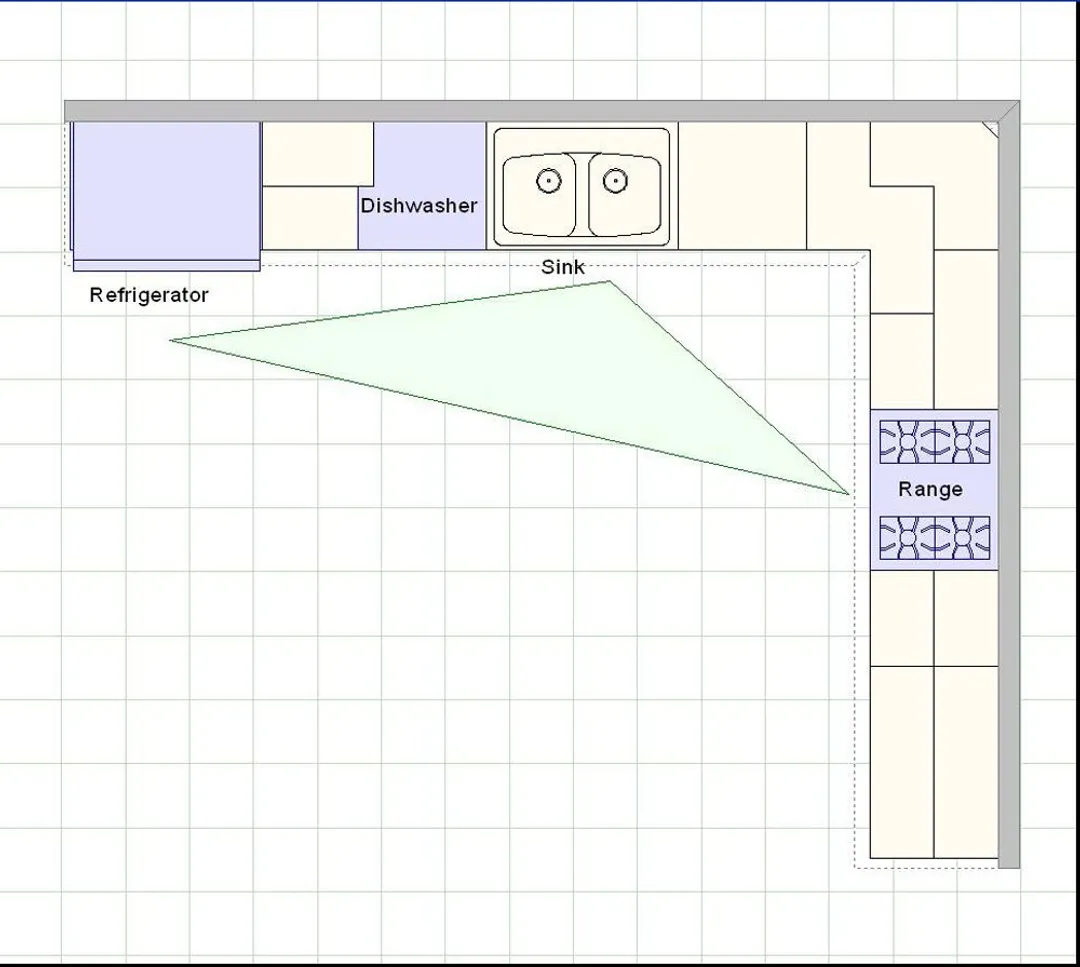
From an ergonomic perspective, this L-shaped design is the most efficient. If you take a gander at the fridge, the sink, and the stove top in the schematic above, they are arranged in a classic three-point triangle. So, maneuvering and working in this space is going to be a piece of cake.
This design is best used in smaller kitchens with an open plan setup. In an enclosed kitchen, this layout could be used if two out of four walls are obstructed by doors or windows.
A good example of an L-shaped kitchen is the design below by Erin Serventi from E.L. Designs.
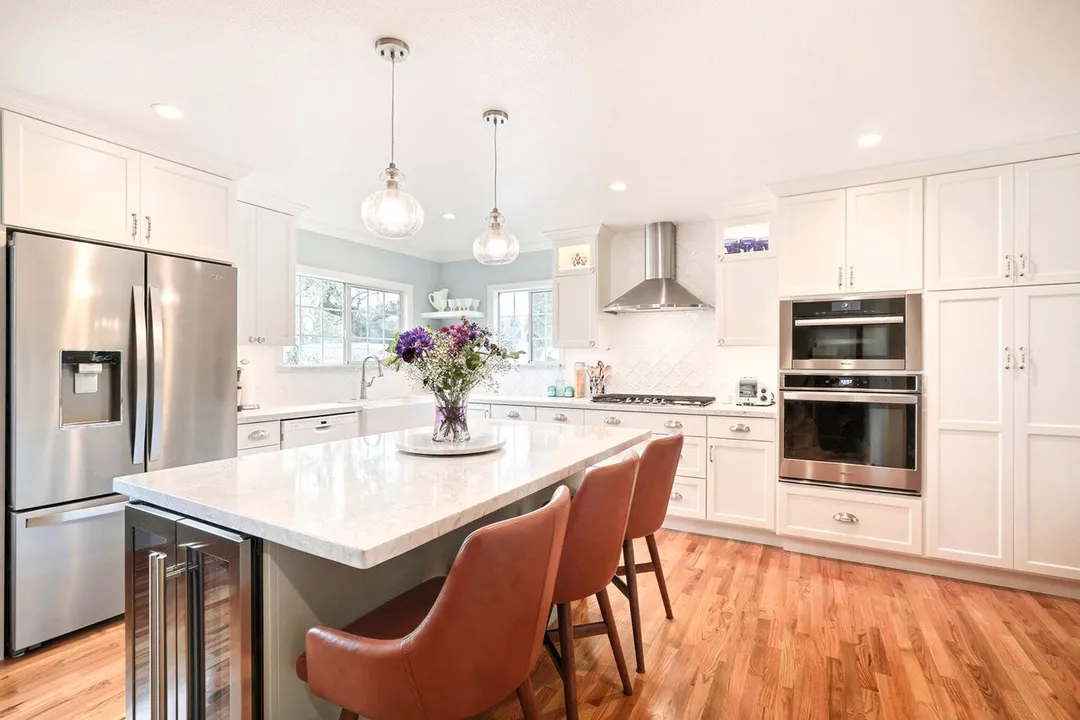
In the design shown here, you have two legs running alonag the two adjacent walls. Each leg is made up of countertops with cabinets both below and above.
The shorter leg (to the left) has a small countertop and a sink. The rest of the empty space is filled with the refrigerator and a cupboard at the top.
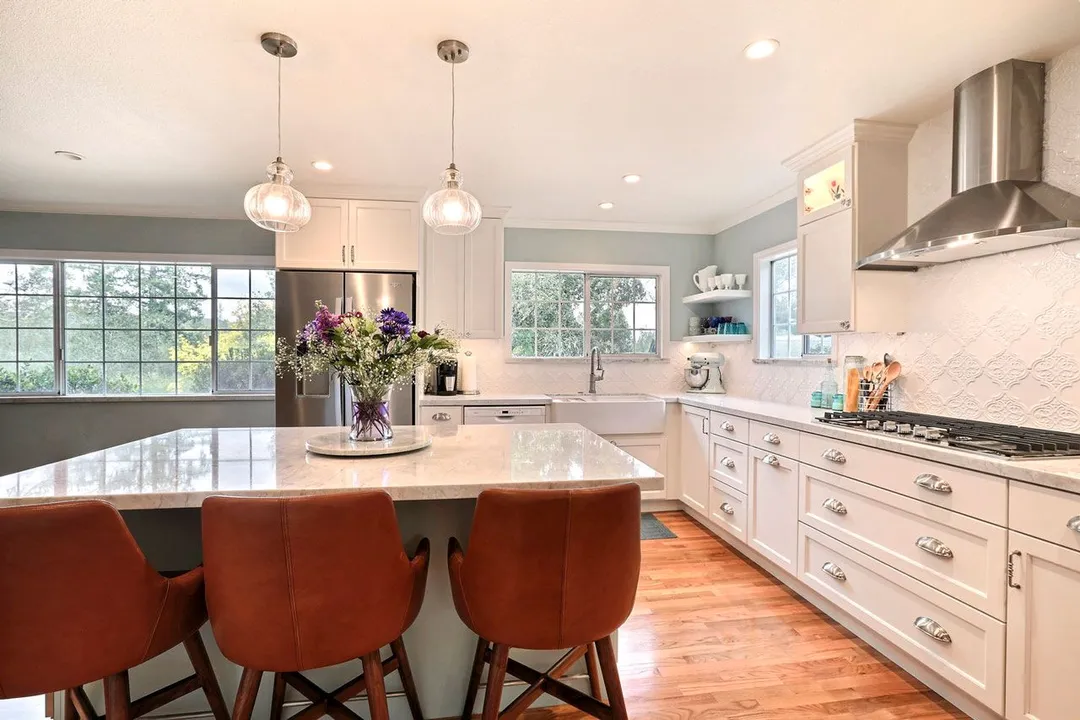
Meanwhile, the longer leg to the right offers more counter space. Thus, it is packed more densely. A stove top is installed here with the cooking range built directly on top. Next to it are a lot more cabinets and drawers, as well as the extra space for an oven and microwave.
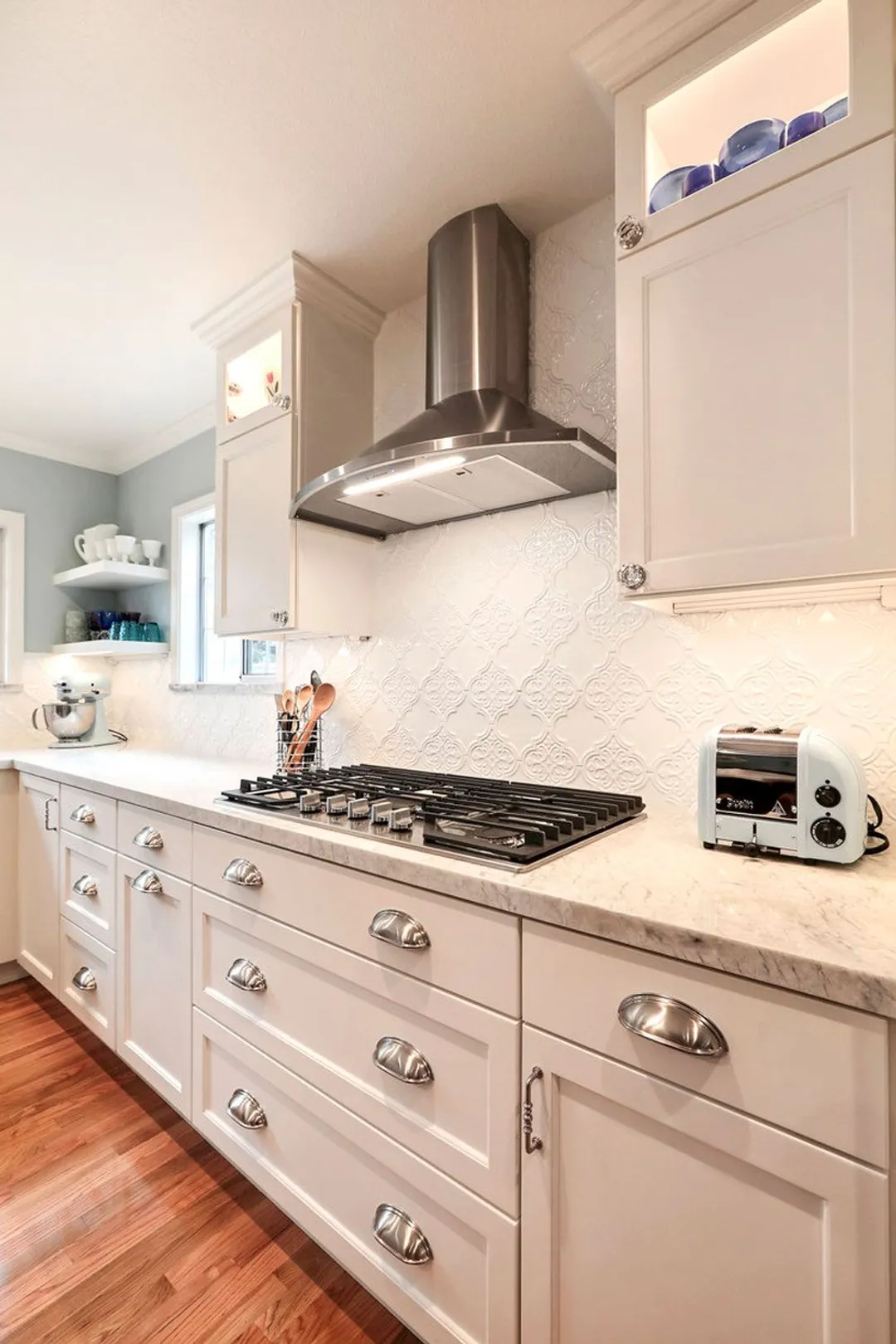
If you have enough space, an island can be added to enhance the functionality of the kitchen. It can serve as a dining area or an ad-hoc working area thanks to the added stools. If you want it to be an entertainment or guest reception area, an integrated beverage locker (as shown in the design here) makes a great addition.
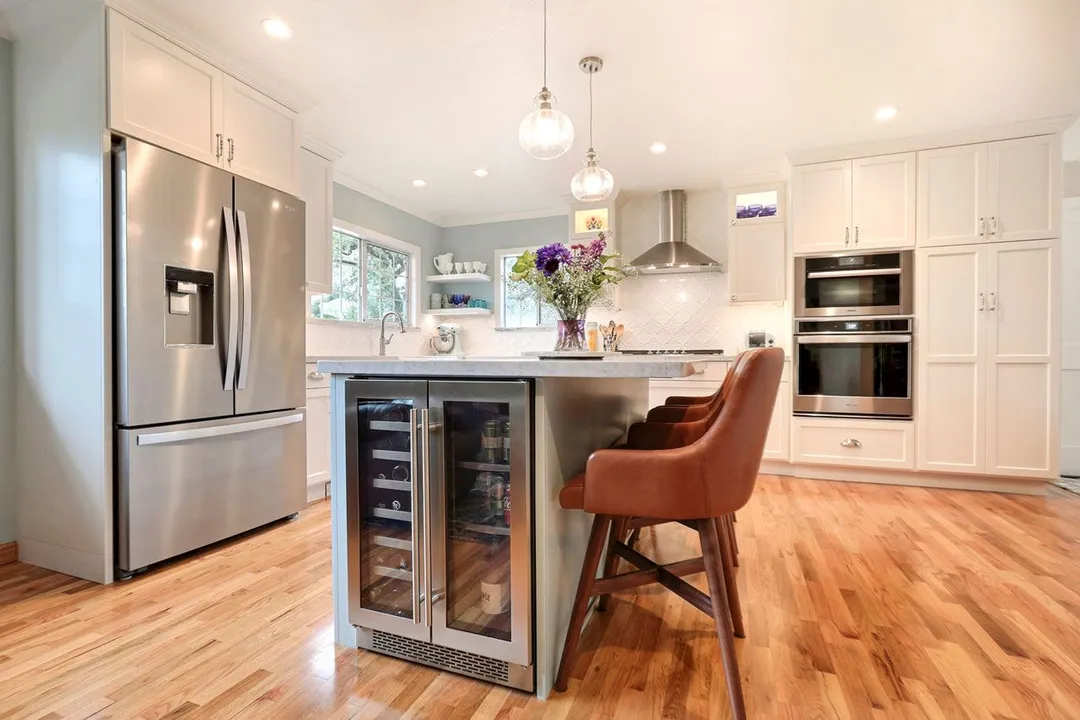
There are, however, a few notable disadvantages.
It’s difficult to implement effectively if your kitchen doesn’t have an open-plan layout. You would end up with two empty walls. All that wasted space could be put to use with added cabinetry and countertops. Thus, a U-shaped or G-shaped layout would make more sense.
While an L-shaped kitchen is great for two cooks working simultaneously, it is not ideal if you have three or more cooks in your household. The small space impedes comfortable movement if too many people are working at once. Yet another reason why you should only use this layout if you have a smaller kitchen.
Lastly, the area in the corner is very difficult to access. If you put a cabinet there, you may find yourself never using it because it’s such a challenge to reach. But there is a simple enough fix: use open shelves or a Lazy Susan.
The U-Shaped Layout
Pros | Cons |
|---|---|
Suitable for medium to large-sized kitchensCan facilitate an efficient work triangleCan be used by multiple cooks at onceProvides a lot of storage space | Not suitable for small kitchensCould feel claustrophobic |
The U-shaped layout is suitable for medium to large-sized kitchens. This layout involves arranging the countertops and cabinetry in three segments running along three adjacent walls. One wall is left intentionally open for access.
Like its name suggests, the final plan will resemble the letter U.

Similar to the L-shaped layout, the U-shaped kitchen can facilitate a text-book work triangle. Thus, it is an efficient design by nature.
If your household has multiple cooks, a U-shaped layout is significantly better than L-shaped too. Because the countertops surround the cooks, multiple people can inhabit and work inside of the kitchen without it being too cramped.
This design from designer Christine Kimberlee is a great visualization of what a U-shaped kitchen can look like.

All three walls of the kitchen are filled up with base cabinets, countertops, and overhanging cabinetry. As you can see, there is a huge amount of work surfaces just along the walls alone. There should be no issue at all for multiple people to work simultaneously within this kitchen.
Other than work surfaces, a U-shaped layout also offers plenty of space for extra upper-wall cabinets to be added. If a large amount of storage space is what you’re hoping to get with your next remodel, this layout is excellent.
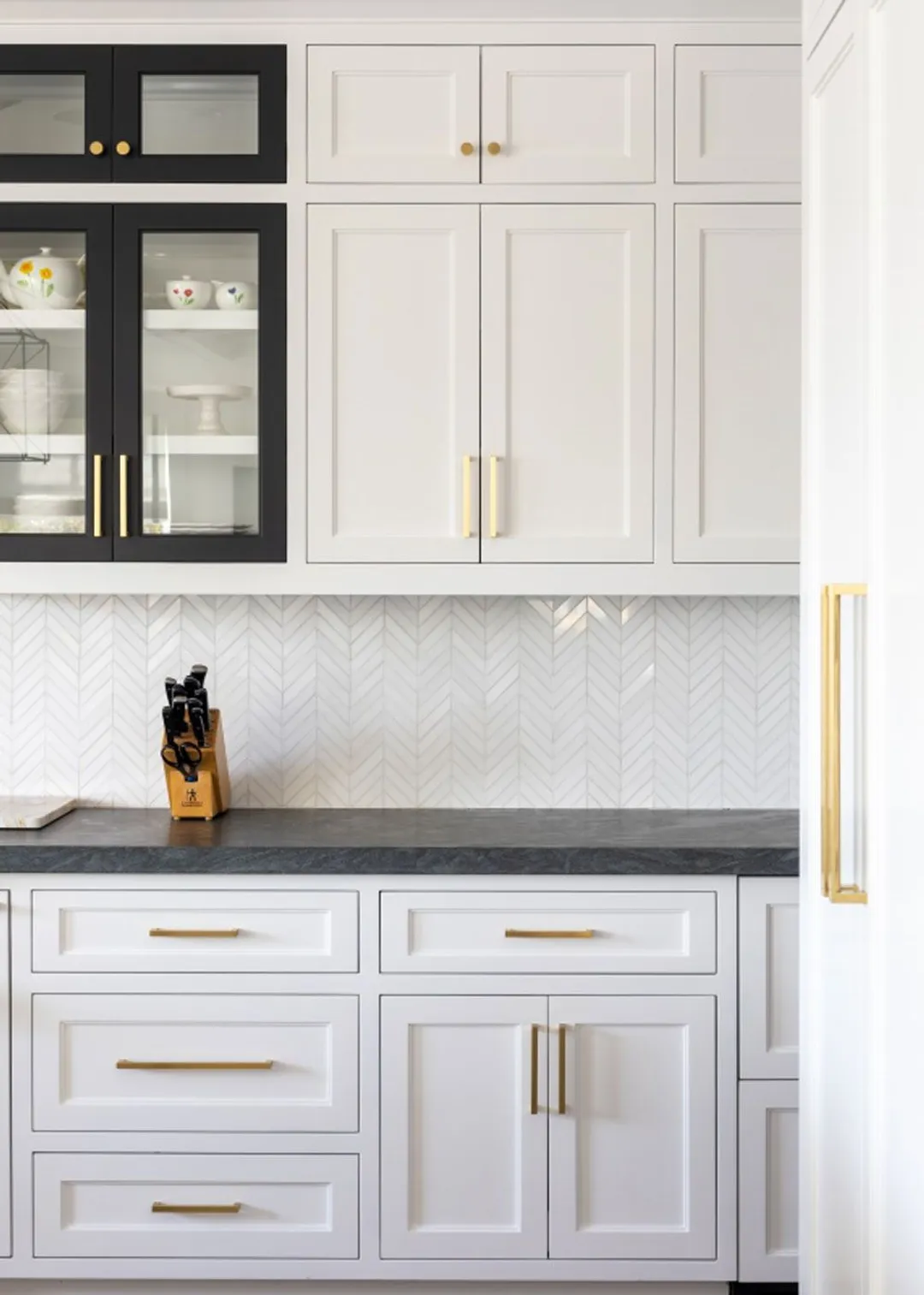
A kitchen island can be added to give your kitchen extra functionalities. The white marble top island below can function as both a dinner table and storage space with the cabinets underneath. But the ingenuity here lies in the second sink on the far end. With it, the island can double as another cooking surface, too.

While the extra storage space it offers is great, this could be a bad thing if it’s not done properly. Add too much cabinetry into a space and it could start to feel claustrophobic. The sensation would be especially pronounced if your kitchen is on the small side.
If your kitchen doesn’t have any windows, we recommend only installing cabinets on one or two walls. Break the mold with the third wall by installing open shelves or a range hood. If your kitchen does have windows, leave the area surrounding them uncluttered to give the space a feeling of openness and to let the light freely shine in.
The U-Shaped design really is not suitable for small kitchens. It doesn’t make sense to add so many cabinets into your kitchen if you don’t have a lot of real estate to work with. Not only would it feel very closed-in, it would also be very difficult to walk around and work in such a kitchen.
The G-Shaped (Peninsula) Layout
Pros | Cons |
|---|---|
Suitable for medium to large-sized kitchensCan facilitate an efficient work triangleProvides a lot of storage spaceExtra storage and working space from the peninsula | Not suitable for small kitchensDifficult to enter and exit the cooking areaCould feel claustrophobic |
The G-shaped (or “peninsula”) layout is the modified version of the U-shaped layout.
Like the previous design, you have countertops and cabinetry running along three adjacent walls. But where this layout differs is the addition of a peninsula jutting out from one wall.
On the blueprint, this small addition turns the U-letter shape into a G.
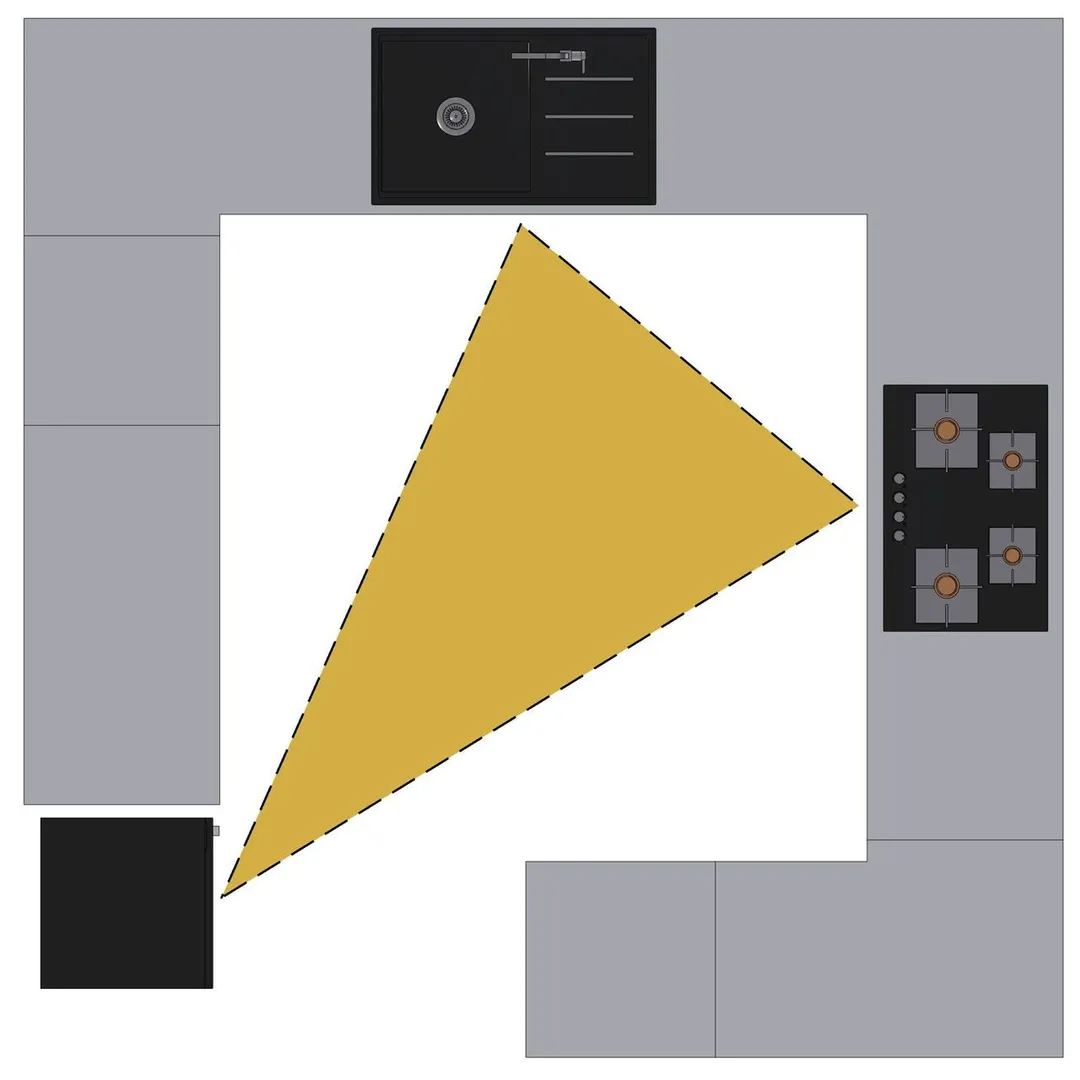
Because it is a variation of the U-shaped layout, it has virtually the same characteristics as the previous design.
It works best in medium to large-sized kitchens. Similarly, as you can see above, the layout can create a pretty seamless work triangle. The all-around design of this type of kitchen also allows multiple cooks to work in tandem without too many difficulties.
With the addition of a peninsula, you get more space for cooking and storage. But you may also use it for other purposes such as a dining or work area like in the design below by designer Mary Jo Fiorella.

This design sample presents the greatest advantage of a G-shaped layout. If you want a kitchen island but don’t have the necessary space for one, adding a peninsula like the above will achieve the same effect.
It is also a great solution if you have an enclosed kitchen that is too small. If possible, simply remove a wall and put a peninsula in its place. It will immediately open up the kitchen and make it a lot more breathable without sacrificing storage or work space.
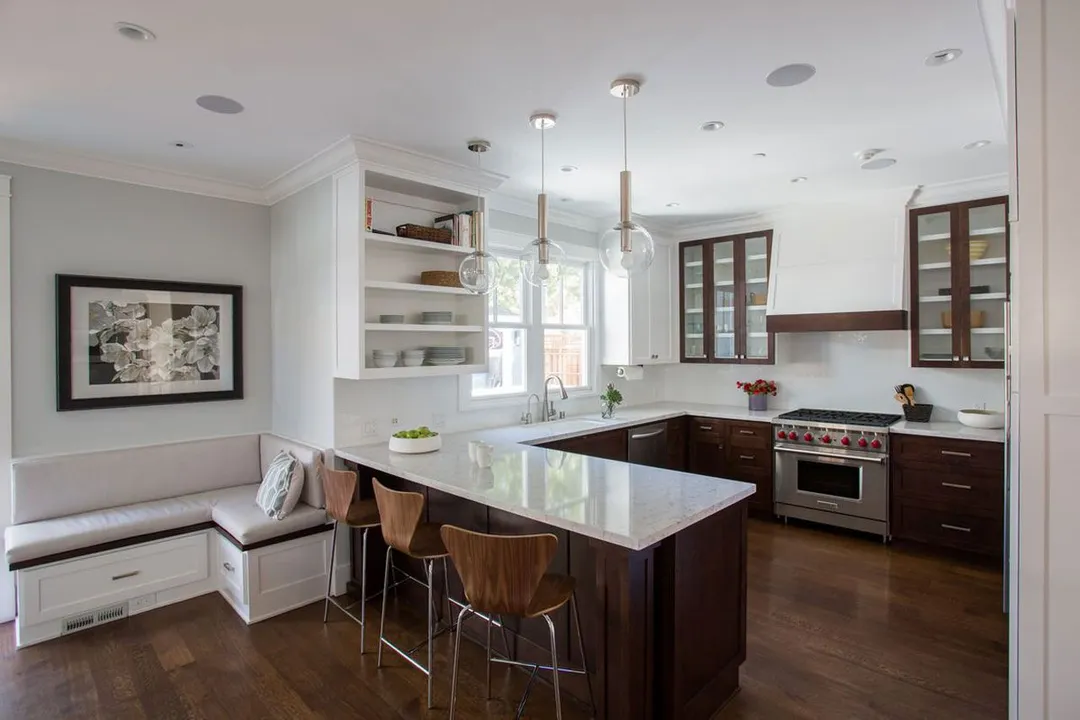
But there is a glaring problem with this design: there is only one way in and out of the cooking area. The peninsula leaves only one narrow access point. This could be a problem if you have more than one cook entering and leaving the space.
Furthermore, it also suffers from the same claustrophobic problem of U-shaped kitchens. With so many cabinets everywhere — both on the ground and up on the wall — the space could feel very enclosed.
The Galley-Style (Corridor-Style) Kitchen
Pros | Cons |
|---|---|
Suitable for small apartments and homesSpace-efficientSimple and cost-effectiveAll services of the kitchen can be easily accessedCompact: opens up the floor plan for other purposes | Not suitable for multiple cooksCould feel closed-offCould affect resale value |
If you only have a narrow space to use for your kitchen, a galley-style (or “corridor-style”) layout would be best. The layout consists of two parallel rows of countertops with a walkway in-between.
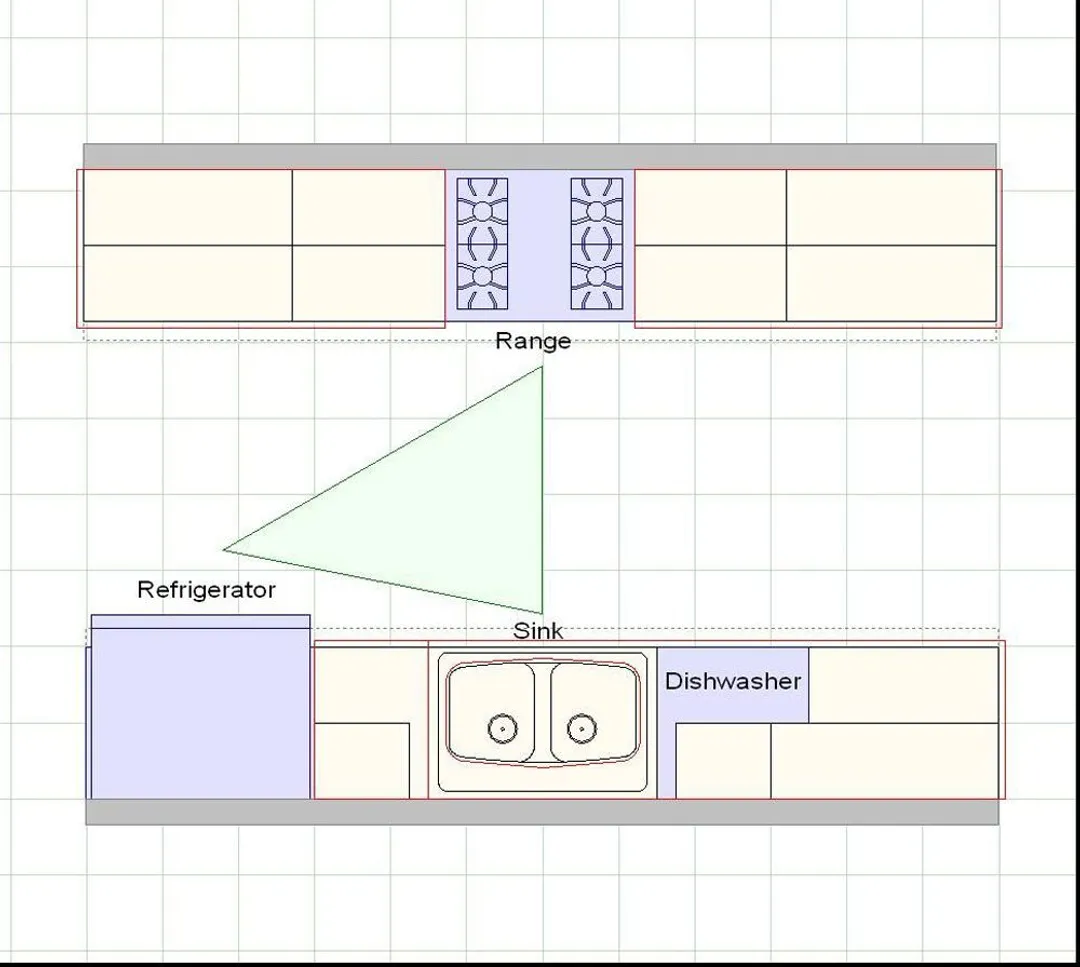
Arranging the stove top on one row, then a sink and the refrigerator on the other will give you a good work triangle. But because there is only one thoroughfare in and out of the cooking area, this layout is not suitable for use by multiple cooks.
A galley-style kitchen is one of the most space-efficient layouts out there. The first advantage is that it doesn’t require you to install corner cupboards. Therefore, every inch of space available is used to the fullest extent.
It is simple and highly cost-effective too. There aren’t many tricky details or special appliances that you need to add to make a galley-style kitchen work. Plus, because you only need to add two short rows of cupboards and cabinetry, it’s a lot more affordable to build than other layouts.
Due to its relative simplicity and efficient use of space, the galley layout is used often in smaller apartments and homes. It is also a good solution for houses that are long instead of wide.
From 3W Design, Inc, this classic, French-style galley kitchen is what this layout could look like in real life.

Appliances, base cabinets, and upper-wall cabinets are packed densely along the two walls of the cooking area. This is not necessarily a bad thing. Because everything that you would need while cooking is within arm’s reach, your work can be a lot more efficient.
However, this also presents one of the key disadvantages of this design. The density of bulky cabinetry and appliances could make the space feel small and claustrophobic.
Therefore, add as much light to the space as possible. And if your floor plan allows it, open up the kitchen to the outside using windows, bifold doors, or doors with glass panelling like the sample below. Extra natural light will make the space feel larger and less stifling.
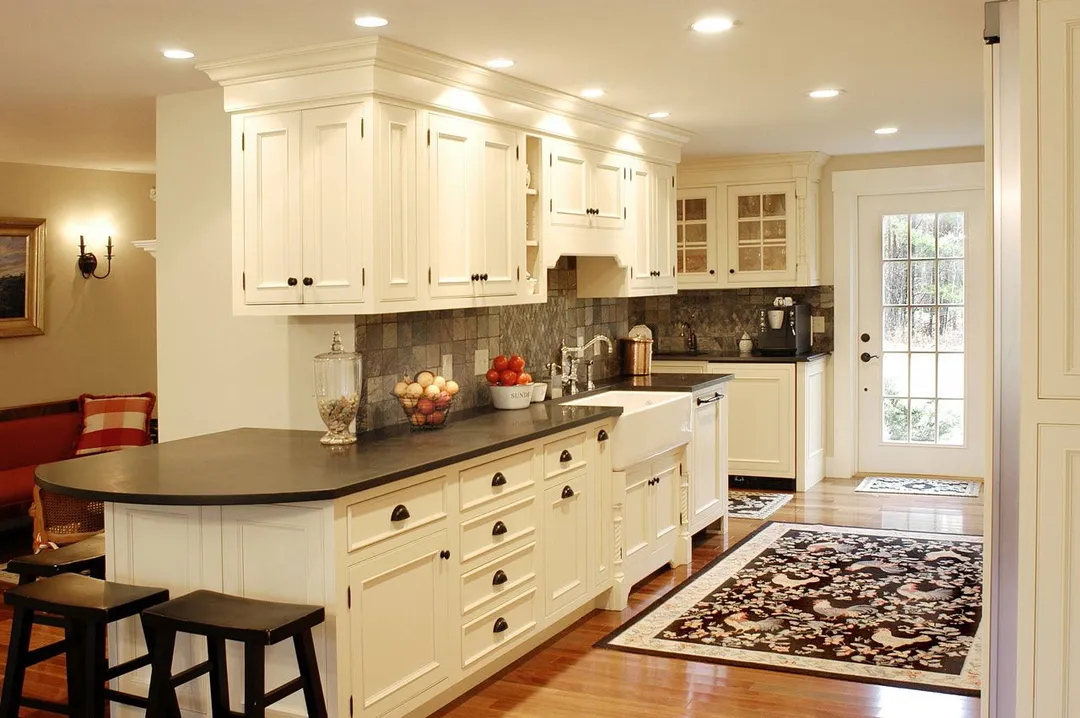
Due to the compactness of the kitchen, it can leave a lot more space on your floor plan to be used for other purposes. For example, you can add a full-blown dinner space to the house without having the kitchen in the way.

If you are a fan of kitchen islands though, there may not be enough space to add one. Also, there’s no real need for one as the tight fit between the two rows of base cabinets would make a kitchen island redundant.
And if you’re planning to resell the house in the future, be careful. If your house plan can accommodate a larger kitchen, remodelling in this style could negatively affect your place’s value as trends run towards open plan and copious work and storage space.
The One Wall Kitchen
Pros | Cons |
|---|---|
Suitable for very small apartments and homesSpace-efficientSimple and cost-effective | Not suitable for multiple cooksDoesn’t offer a lot of work surface or storage space |
This is the premier kitchen solution for very small homes and apartments. The cooking area is distributed along a single wall. It is simple and highly minimalistic, but doesn’t sacrifice much functionality in the process.
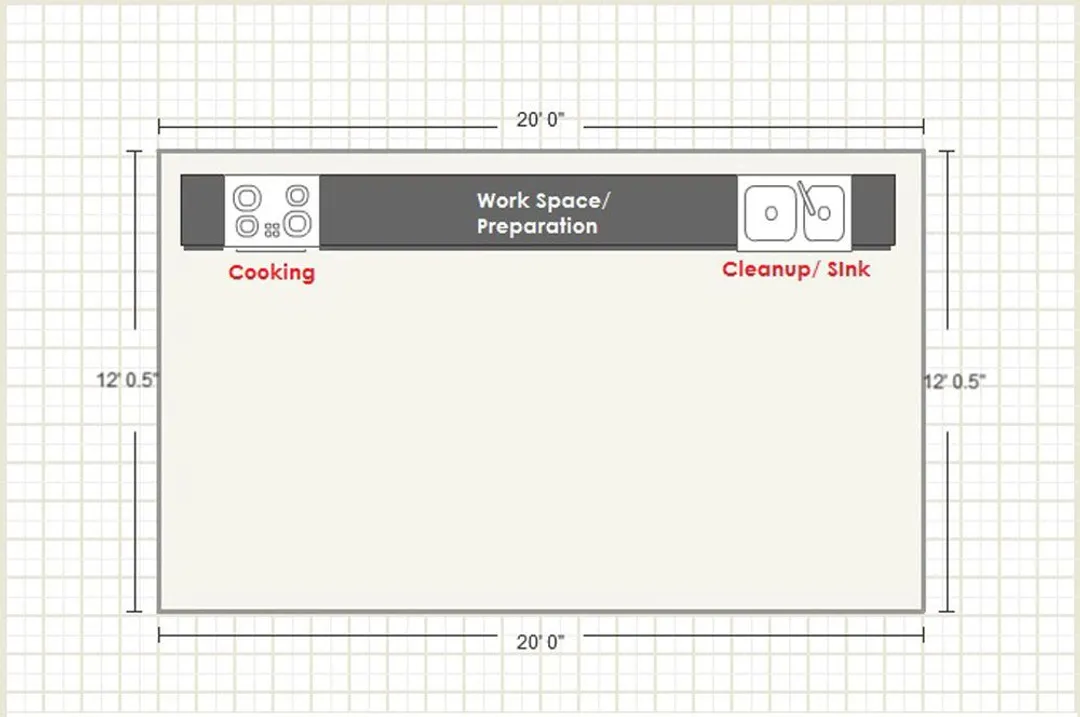
Even simpler than the galley-style kitchen and more space-efficient, it is a great solution for small families and singles. And with only one row of appliances and cabinetry to worry about, this style is the most cost effective out of the quintet of layouts. If you’re remodeling on a budget, do consider this style.
Ergonomics-wise, all of the appliances, drawers and cupboards are concentrated in a single place. So, the cook can easily reach and access everything needed while they are working.
However, as expected, there are quite a few cons to the design.
First, it obviously isn’t suitable for multiple cooks. Two cooks is the limit for a one-wall kitchen, and even then it’s a squeeze.
Secondly, compared to other layouts, a one-wall kitchen doesn’t offer a lot of work surfaces or storage space. It is possible to remedy this issue by adding extra upper-wall cabinets on the surrounding walls. If space allows, you can add a kitchen island too.
For sampling purposes, here is a one-wall kitchen design with a country motif from Rockwood Cabinetry.
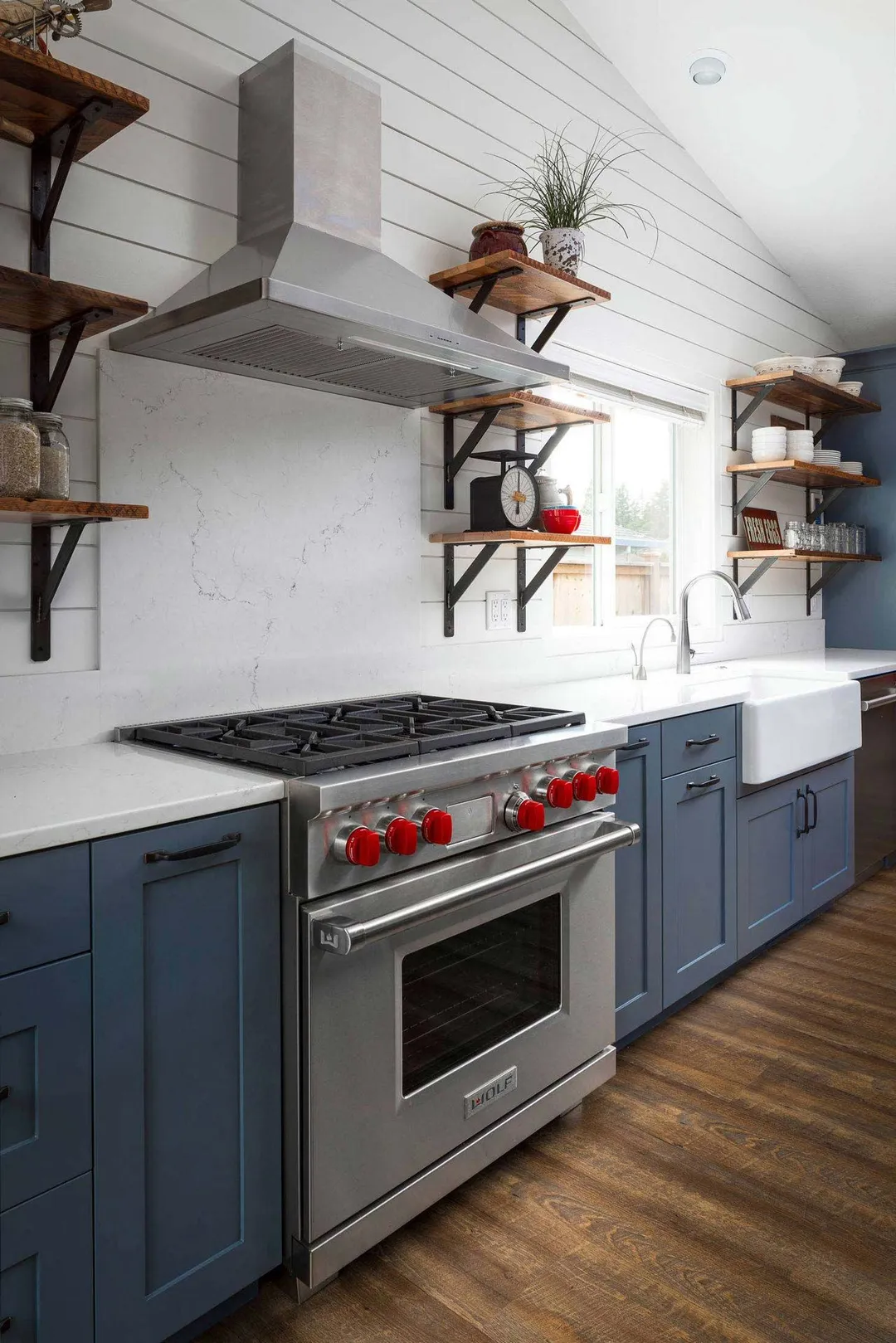
Everything that a cook would need to work is concentrated on a single wall. From the base cabinets, to the open shelves, the sink, the refrigerator, and the stovetop, everything is within arm’s reach. As a result, although it doesn’t really conform to the traditional work triangle principle, it is still an ergonomic design.
With the integrated kitchen island, you get a little bit more storage space that can be used to store ingredients, cutlery, or knick-knacks such as books. The island itself can be used as an extra cooking surface, a dinner table, or a work and entertainment area.
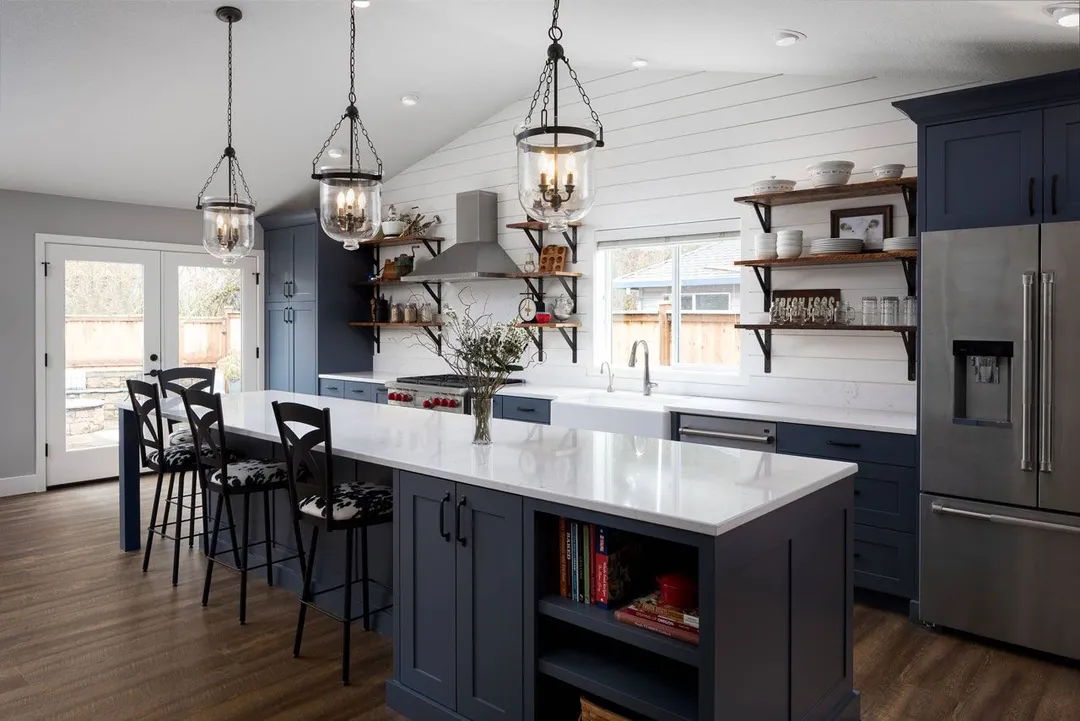
In this design in particular, Rockwood Cabinetry has also added a wine shelf to the farthest side of the cooking area. This further bolsters the kitchen’s function as an entertaining or guest-receiving area.
While a one-wall kitchen may not offer a lot of room, with a good eye for design, you can give it all sorts of functionalities despite its size.

Conclusion
These five basic kitchen layout ideas are merely a guide, not a rule. Remember, the only limit to design is how creative you are at utilizing the space, materials, and budget you have. But if you do decide to deviate from the norms, keep in mind that the kitchen is a functional space. Aesthetics must complement function, not the reverse. So, ensure that whatever layout you end up choosing, it is one that is ergonomic and efficient for you and others in the household.
Authors
Luna Regina is an accomplished writer and author who dedicates her career to empowering home cooks and making cooking effortless for everyone. She is the founder of HealthyKitchen101.com and HealthyRecipes101.com, where she works with her team to develop easy, nutritious recipes and help aspiring cooks choose the right kitchen appliances.



